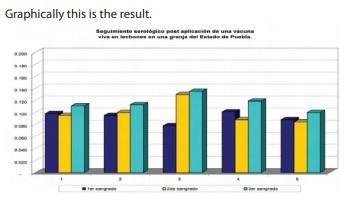Post serological monitoring of a live vaccine implementation swine erusipela in piglets on a farm in Puebla State in Mexico
Published: June 7, 2021
By: Oscar Huerta Alva; E. V. Vivanco; Y. L. Santos; L. Valencia / Laboratorios Sanfer SA de CV, Mexico, DF, Mexico.
Erysipelas is a contagious infectious disease of pigs caused by the bacterium Erisipelothrix rhusiopathiae. The Swine Erysipelas is an actual disease, as reported Schwarts (AASV 2002) with the increase of cases at the University of Iowa, with economic impact in the herd losses may include loss of death (1%) - $ 2.50dls/hembra; treatment cost $ 1/hembra; abortion (4%) - $ 5dls/hembra for a total of $ 10dls/hembra. Also in the growth stage - complete the death loss (3%) - $ 2.50dls; treatment cost $ 1dls; retarded (3%) - $ 1.25dls for a total of $ 4.75dls/cerdo the market. The cost of an outbreak can be high, and this does not include effects on carcass quality, or forfeitures. In 2008, in traces of Sonora, Queretaro and Mexico City for the confiscation of channels because of erysipelas (personal communication) has been frequent.
Sierra (2006) reports that Erysipelas is the second most isolated bacteria in the presence of PRRS in farms of Guanajuato, Jalisco, Michoacan and Perea (2006) reports that 90% of animals tested in the State of Mexico are positive Erysipelas, Huerta (2006-2008) reported 80% incidence of seropositivity in Sonora. According to remarks by Dr. Calderon (personal communication) 75% of the farms of La Piedad and Tepatitlán have subclinical Erysipelas.
Materials and Methods
The aim of this study was to monitor the serological to 5 piglets before and after application of a live vaccine and see if through the Elisa test (kit for the detection and/or quantification of specific antibodies Erisipelotrix rhusiopathiae INGENASA pig serum) we identified a serological response at 30 and 60 days after vaccination. The piglets are from a farm of 1,100 stomachs located in the State of Puebla, stable PRRS virus and by late last year introduced Erysipelas problems and proceeded to vaccinate the herd and piglets savanna around week 7 of age. 5 piglets were selected at random, were identified individually and they took blood samples at day 1 (before vaccination) and 30 and 60 days after vaccination, sera were sent to Diagnostic Laboratory IASA, obtaining the following results.


Discussion
3 / 5 piglets showed a decrease in the immune response during the 2nd bleeding and 5 / 5 piglets have a greater serological response and uniform prior to vaccination. We believe that using the Elisa test for the detection and/or quantification of specific antibodies in swine serum Erisipelotrix rhusiopathiae (INGENASA) can be used to measure the response post vaccination, but this work must be replicated again to set specific parameters post-vaccination response, since this kit is designed to identify negative animals, suspicious and positive in the presence of erysipelas in the field, which we know will change the immune response towards each individual and the degree of infection present. For the third bleeding, we can see that there is a similar response in 5 cases. It is noteworthy that farm animals had clinical symptoms of Erysipelas and after vaccination this extint.
Presented at the 21st IPVS Congress, Vancouver, Canada, July 18-21, 2010.
References
1. Perea, CML, et al. Determinación de anticuerpos contra Erisipelothrix rhusiopathiae.en sueros de cerdos utilizando una prueba sencilla de aglutinación., Congreso AMVEC, 2006.
2. Huerta, AOF; Montaño MB, Reporte de casos de Erisipela porcina en el Estado de Sonora, Congreso AMVEC, 2006
3. Huerta, AOF; Montaño MB, Reporte de casos de Erisipela porcina en el Estado de Sonora, IPVS, 2008.
4. Schwartz, K.J.,2002, Erysipelas: an old disease returns to the swine industry or something NEW?, American Association of Swine Veterinarians. 5. Sierra, N., Multi etiologías complejas de interacción entre PRRS y otros patógenos. Congreso AMVEC, 2006.
5. Wood, R.L., 1999, Erysipelas. In Diseases of Swine 8th Ed, ISU press, Ames Iowa.
Related topics:
Authors:
Influencers who recommended :
Oscar HuertaRecommend
Comment
Share

Would you like to discuss another topic? Create a new post to engage with experts in the community.






.jpg&w=3840&q=75)